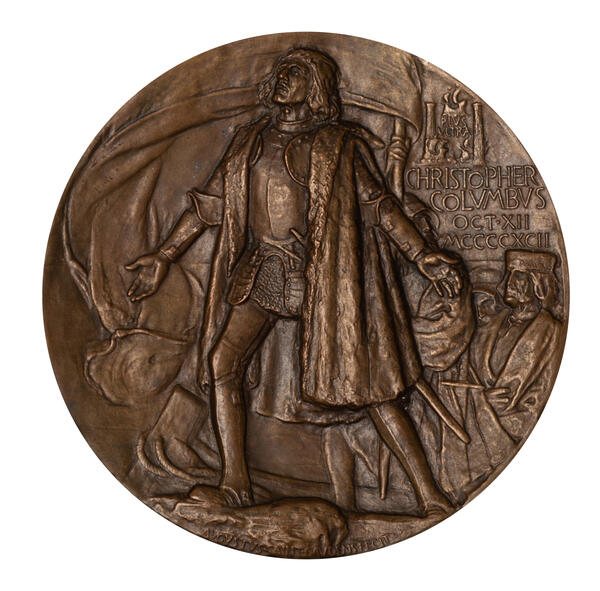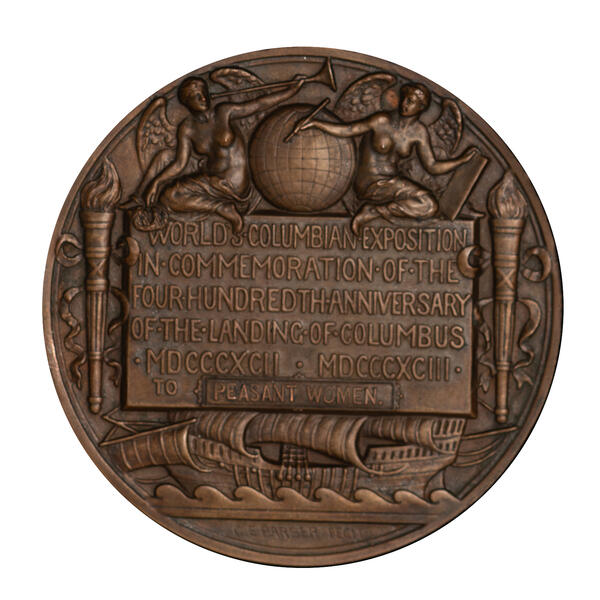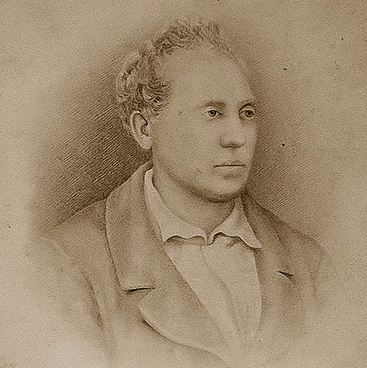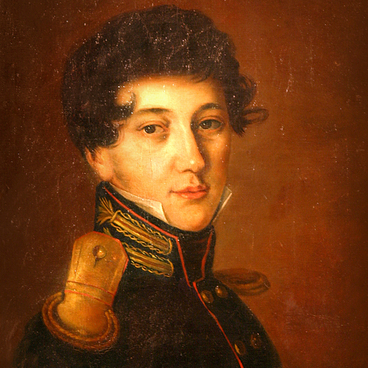The 1893 World’s Exposition was held in Chicago and remains one of the largest in history. The event celebrated the 400th anniversary of America’s discovery. Hence the name Columbian. The Russian exposition included many different exhibits. Among them were paintings by Ivan Aivazovsky, Ilya Repin and Konstantin Korovin, much sought-after by foreigners furs and fabrics, porcelain and icons, as well as numerous handicraft products from Russian artisans.
The bronze medal from the museum’s collection was awarded to the work of peasant women embroidery from the Boratynskiy and other villages of the Kazan governorate. On its flip side, which is called the reverse, you can see an inscription ‘Peasant Women’ (‘Krestyanki’).
Olga Boratynskaya (1844-1918), the daughter-in-law of the poet Evgeniy Boratynskiy, recalled: ‘In 1893 I sent peasant works to the exhibition in Chicago through Kazan county council and received from there a positive review and bronze medal’.
Her daughter Ksenia Alekseeva in her book ‘My Memories’ described the history of this peasant guild as follows: ‘Back at the time mother… began distributing handicrafts among the women of the surrounding villages. The main branch was embroidery on finger loop cloth… Peasant women began to flock from distant villages, motivated by good wages. Orders began to arrive from Moscow and Petersburg… even from Paris. These works were exhibited in many places, both in Russia and abroad (in Nizhny Novgorod, Kazan and in Chicago). Seeing as the business goes well, mother organized the guild which united all the workers… The guild existed until the revolution of 1917’.
The design of the medal was designed by American artist and sculptor Augustus Saint-Gaudens a year before the opening of the Chicago World’s Exposition. Its obverse was decorated with the image of Columbus stepping ashore. The other side was designed by Charles Barber, who worked at the Philadelphia Mint. The medals of the Chicago Exposition were awarded to participants for their achievements and were custom-engraved.
The bronze medal from the museum’s collection was awarded to the work of peasant women embroidery from the Boratynskiy and other villages of the Kazan governorate. On its flip side, which is called the reverse, you can see an inscription ‘Peasant Women’ (‘Krestyanki’).
Olga Boratynskaya (1844-1918), the daughter-in-law of the poet Evgeniy Boratynskiy, recalled: ‘In 1893 I sent peasant works to the exhibition in Chicago through Kazan county council and received from there a positive review and bronze medal’.
Her daughter Ksenia Alekseeva in her book ‘My Memories’ described the history of this peasant guild as follows: ‘Back at the time mother… began distributing handicrafts among the women of the surrounding villages. The main branch was embroidery on finger loop cloth… Peasant women began to flock from distant villages, motivated by good wages. Orders began to arrive from Moscow and Petersburg… even from Paris. These works were exhibited in many places, both in Russia and abroad (in Nizhny Novgorod, Kazan and in Chicago). Seeing as the business goes well, mother organized the guild which united all the workers… The guild existed until the revolution of 1917’.
The design of the medal was designed by American artist and sculptor Augustus Saint-Gaudens a year before the opening of the Chicago World’s Exposition. Its obverse was decorated with the image of Columbus stepping ashore. The other side was designed by Charles Barber, who worked at the Philadelphia Mint. The medals of the Chicago Exposition were awarded to participants for their achievements and were custom-engraved.




